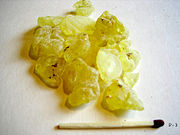 Black lumps of prehistoric tar with human tooth impressions have been found in Northern Europe dating from approximately 7000 BC (Middle Stone Age) to 2000 BC (Bronze Age). The bite impressions suggest that most chewers were between 6 and 15 years of age.
Black lumps of prehistoric tar with human tooth impressions have been found in Northern Europe dating from approximately 7000 BC (Middle Stone Age) to 2000 BC (Bronze Age). The bite impressions suggest that most chewers were between 6 and 15 years of age.The Greeks chewed resin from the mastic tree (mastic gum) (shown on the right). North American Indians chewed spruce gum.
The first manufacturing patent for chewing gum was issued in 1869 for a natural gum, chicle, derived from the Sopadilla tree, indigenous to Central America.
Chewing gum sold today is a mixture of natural and synthetic gums and resins, with added color and flavor sweetened with corn syrup and sugar.
The medical literature contains very little information about the adverse effects of chewing gum.
A report (see below) describes 3 children who developed intestinal tract and esophageal obstruction as a consequence of swallowing gum.
References:
Chewing gum bezoars of the gastrointestinal tract. Milov DE, Andres JM, Erhart NA, Bailey DJ. Pediatrics. 1998 Aug;102(2):e22.
A moment on your lips, forever in your intestine. NCBI ROFL.
Children chewing xylitol gum were 25% less likely to develop acute ear infections. NYTimes, 2011.
Image source: Mastic resin. Wikipedia, GNU Free Documentation License, Version 1.2.